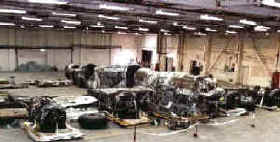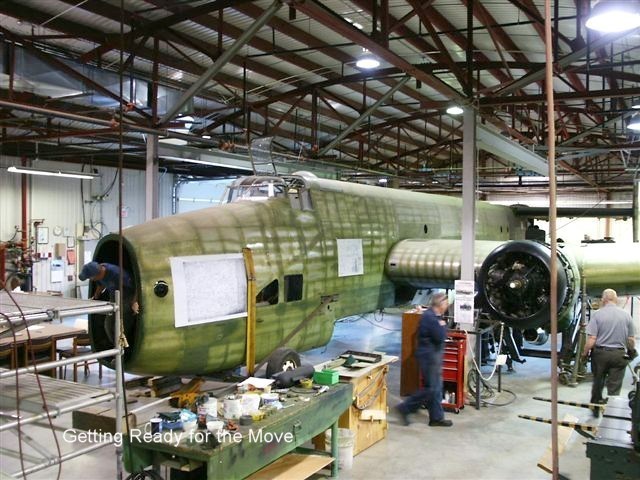The Story of The
Halifax Bomber
NA 337
Why
is the Halifax so important a part of Canada's Air Force heritage?
Because
29,000 operational Halifax missions out of a total of 37,000 in World War
2 were flown by Canadian crews. We must always remember that 50,000 RCAF
personnel served in Bomber Command, of whom 10,000 gave their lives.

the story: Halifax A Mk VII aircraft number NA 337 was
assigned to 644 Squadron of the RAF, on "Special Duties" work which
included dropping supplies to members of the anti-Nazi Resistance
groups in Europe. It was one of 6178 Halifax bombers flown by allied
forces during the Second World War. Only three of these now remain!
The supplies usually consisted of containers containing weapons,
ammunition and explosives. The containers, about 15" in diameter and 60"
long were carried in the bomb bays. One of these container was
recovered from the NA337 drop site in Norway and is on display at the Museum.
The first reference to NA337, in the 644 Squadron Operations Logs,
is on March 24th, 1945, when the aircraft towed a General Aircraft "Hamilcar"
glider, containing a Dodge truck and a 17 pounder gun, on the last great
Airborne operation of World War II: "Operation Varsity", the massive
airborne assault across the Rhine River into Germany.
In
the late evening of April 23, 1945 . . . just 15 days before the end of World
War 2 in Europe . . . NA 337 took off from RAF Station Tarrant Rushton in England, on a mission to drop
supplies to the Norwegian Underground forces near Grue, Norway.
After a successful airdrop early the following morning, NA 337 started the
return journey to England. Unfortunately its heading took it over an
important and well-protected bridge, at the southern end of Lake Mjosa,
where it came under accurate fire from a German anti-aircraft (flak)
installation.
A shell penetrated the starboard wing, igniting the fuel tank, and causing the
two engines on that side to fail. Faced with no other alternative the pilot was
forced to crash-land the aircraft in the lake.
The landing was rough but successful, and all of the crew of six managed to
escape before it sank in 750 feet of water. Sadly, because of the cold
temperatures, only one person . . . Flt Sgt Thomas Weightman, the
rear-gunner . . . managed to survive. About six hours after the crash, he
was found floating on an overturned dinghy. Later he was taken by the Germans to Oslo to await
transport to a prison camp in Germany. Fortunately, before he was moved
again, the war ended and he was repatriated to England.
For the next forty years NA 337 would lie in the icy depths of Lake Mjosa about
two kilometres from shore . . . lost, but not entirely forgotten. Then, in the
1980s it was located by two Norwegians, Tore Marsoe and Rolf Liberg.
Marsoe, as a boy of sixteen, had heard the aircraft crash in 1945, and had
never lost interest in it. Together with Liberg, he finally located the aircraft
in the mid-1980s. The news
spread, but no further salvage action was taken until, in the 1990s, Karl Kjarsgaard, a Canadian Airlines pilot and Jeff Jeffery DFC a WW2 Halifax pilot,
came up with a plan to salvage and restore the aircraft.
As a result the Halifax Aircraft Association, with over three
thousand members, was formed to provide impetus and seek funding and assistance
for the project. On September 3, 1995, after a great deal of work by many
dedicated individuals from Canada and Norway . . . and with Flt Sgt Weightman in
attendance, NA 337 finally broke the surface of Lake Mjosa again.
Subsequently, it was taken by Canadian Forces Hercules aircraft from 8 Wing,
Trenton to its final destination, the RCAF Memorial Museum.
HEADING HOME! THE MOVE OF THE HALIFAX
The Restoration Challenge!

Halifax NA 337 on arrival at Trenton
After the Second World War all of the remaining
Halifax aircraft
were scrapped. Today, from a total of over 6000 which were built, only three
remain, two of which are in England: the first a composite rebuild which
incorporates parts from other Halifaxes and another type of aircraft, the
second preserved as a crashed aircraft, and now NA337 which is the
only technically correct Mark 7 aircraft in the world. The majority of the
restoration work on NA 337 was done by a highly skilled force of
volunteers, including many veterans.
For more information on the aircraft please
visit the Halifax NA337 page.
There are 23 pictures here which show
different stages of the reconstruction work on the
Halifax and its move into the new museum extension which was still under
construction. They are in
sequence from left to right and by row. Each one has a small title. Please click
on the thumbnails to enlarge and then on your browsers back button to return to
this page.
Now follow this link to view the Official Dedication Ceremony
of the Reconstructed Halifax!









































